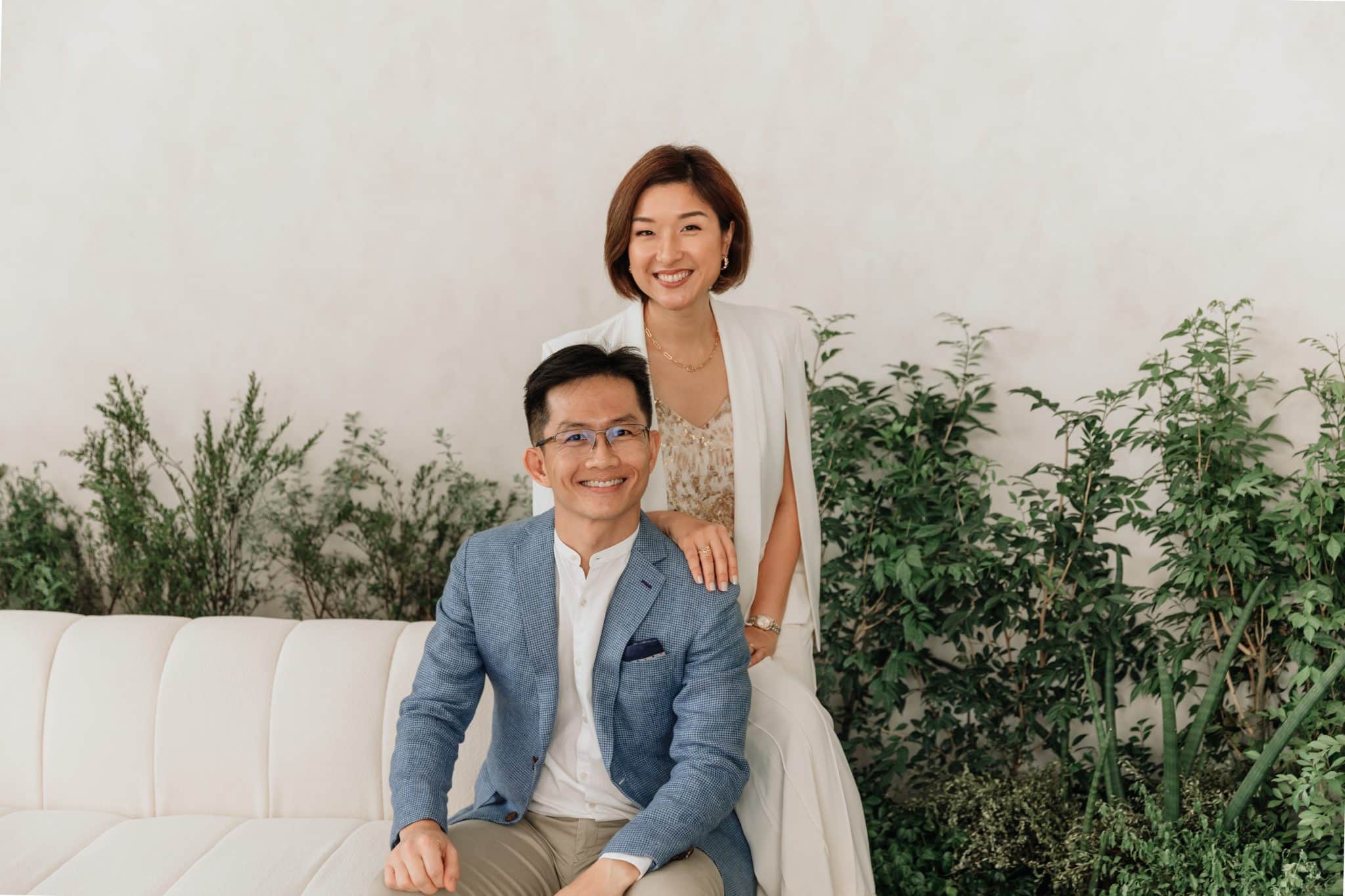“Disagreement is a way of life but there is an art to it”: Ten Butter Fingers marriage workshops are helping couples “fight effectively”
by Christine Leow // October 19, 2023, 4:01 pm

Raymond Teo and his wife Jenny Lie of Ten Butter Fingers fame met in university and run a consultancy together. They now also conduct marriage workshops which are often fully subscribed. All photos courtesy of the Teos.
“What can I do to make you feel better?”
Out of sheer exasperation, Raymond Teo, 49, threw this question at his wife Jenny Lie one day nearly 20 years ago.
At the time, they had only been married a few years but their quarrel was one they had had countless times.
“We were two very tired individuals who barely had time for each other.”
“We were quarrelling about my in-laws,” said Jenny, 47, of home bakery Ten Butter Fingers fame.
“Both of us are very family-oriented. We respect our parents a lot and we love them very much.”
Interjected Raymond, 49: “But how we honour them is different.”
From the start of their marriage, the couple would visit Raymond’s parents every Saturday.
“We live next to her parents. So we see them every day. But my parents stay somewhere else,” explained Raymond who admitted that in that matter he “called the shots”.
For a long while, Jenny went along with this even though at times she wondered if they could reduce the frequency of the visits.
“We were so busy with church ministry, we had housework to do, the kids were young. So we were two very tired individuals who barely had time for each other.

Raymond and Jenny (centre) with their daughter Cheryl, 19, and son Caleb, 17.
“Being the good wife, I would say, ‘Okay.’ But I was silently protesting.”
One day, years into this routine, Jenny blew up.
“I bought into the false narrative of: ‘If you love me, you should know what to do!’”
Recalled Raymond: “Jenny said, ‘If you love them so much, you go back yourself!’ And I was wondering, ‘Where is this coming from?'”
So a quarrel erupted.
Admitted Jenny: “All I wanted was to have a date night. But I never told him I wanted a date night.
“I bought into the false narrative of: ‘If you love me, you should know what to do!’ He became defensive and I shut down.”
This is a story the Teos share with the couples they teach and mentor. They have been running pre-marital counselling courses at their church, Wesley Methodist Church, for the last 21 years, as well as journeying with married couples.
Recently, they started offering marriage workshops to the public: The Art of Disagreement and The Art of Oneness.
Accountants by training and founders of corporate consultancy Play Insight in addition to running the highly successful Ten Butter Fingers, neither had expected to be so involved in a completely different line: Helping couples to build strong marriages.
A heart for marriages
Raymond and Jenny became involved in couples ministry quite by chance. When they were just two years into their marriage, a church staff in charge of running the marriage preparation course asked them to help out.
“Some couples – within a year, year-and-a-half of marriage – they are in a bad space.”
Raymond had been serving in everything from leading a small group to “arranging chairs and flipping transparencies”, while Jenny had been in the dance ministry. But they decided to take up the new challenge because they saw it as an opportunity to serve together.
They began as facilitators, and in time they ran the course. They would not have thought to go beyond the church had Covid not changed how everything was done.
Said Jenny: “When Covid hit, all classes went online. So did marriage prep. I thought: Why not share some of the lessons on my social media page?”
This was 2021 and by then Jenny had quite an online following, thanks to her booming baking business. Soon, people were asking if the Teos could conduct marriage courses for the public.
It took some time to create a new programme. In December 2022, they launched The Art of Disagreement, catering to a wider audience beyond just soon-to-wed couples. They expected only five couples to sign up. Instead, all 15 couple slots were snapped up.

Last year, the Teos decided to make available to the public marriage workshops that help couples “disagree well”. The lessons are drawn from their decades of experience teaching couples in their church.
“We have couples coming in within the first few years of getting married and some who have been married over 30 years.
“What we see is sad. Some couples – within a year, or a year-and-a-half of marriage – they are in a bad space,” said Raymond.
“They are not talking to each other,” added Jenny
Raymond said: “This heightened the urgency of what we are doing.”
Here are some of their tips for reconciling disagreements and building strong marriages.
3 steps towards disagreeing effectively
But why zero in on disagreements? Why not communication as a whole?
“How well couples resolve conflicts is a predictor of their marriage – whether they will thrive or not,” said Raymond.
Yet couples do not naturally know how to “disagree well”.
Said Jenny: “As a young wife, I had this false narrative that we should not quarrel. A happily married couple should not quarrel. We should look peaceful; we should look loving. I tried to keep up a front.
“Now, we want to put this notion up front: Disagreement is normal! But how do we disagree effectively?”
1. Self-awareness
It begins with self-awareness, say the Teos. This is necessary in order to communicate needs and step towards reconciliation.
“Couples come to appreciate that they are different and have different needs.”
“What are our conflict resolution styles? What are our tendencies? Do we tend to avoid? Do we tend to be less emotional?” pointed out Raymond.
“At the workshop, couples come to appreciate that they are different and have different needs.”
Sometimes, spouses can help develop that self-awareness. When Jenny notices Raymond looking “more intense” than usual, she will gently highlight it to him.
“I’ll be curious. I’ll say, ‘You are speaking to me in a mun zang (frustrated) tone. What’s going on?’”
Nodded Raymond: “It signals to me to re-centre.”
Jenny added: “It takes him awhile to figure out that there is something bothering him. But he has been really good over the years; he’s become more aware.”
2. Sensitivity
With that awareness comes a sensitivity to behaviour.
Said Raymond: “Are we sensitive to how our behaviour and actions land on others? For example, if she needs someone to talk to and I give her my indifferent treatment, it will land badly.”
Jenny cited an example.
“If she needs someone to talk to and I give her my indifferent treatment, it will land badly.”
“I used to wonder why he didn’t react the same way as I do. When the kids do something that is upsetting, Raymond would say, ‘I’m not going to let it bother me. I will address the issue when the kids are ready.’
“And I would be like, ‘How can they speak to us in this manner?’
“If he were not sensitive enough to how his indifference lands on me, he would be like, ‘Why are you so emotional again?’ Then I would be, ‘My kids hurt me, my husband doesn’t understand me. Life is really tough.’
“Instead, he realises that I need the space to vent, that I am hurt. Not everyone has to have the same response and it is fine.”
Raymond agreed: “When she gets more anxious, I help her manage her anxiety.”
3. Skills
Regulating our responses to our spouse requires skills that couples do not always have because of a lack of knowledge or good role models.
“During the class, we give couples time to practise speaking to each other so that it lands well and connects them relationally,” said Raymond.
Explained Jenny: “Couples need to connect relationally. To do that, they need to have relational communication, not just functional communication.
“Functional communication is about the day-to-day stuff: ‘Have you bought the rice? Have you picked up the kids?’
“Couples need to have relational communication, not just functional communication.”
“Some couples are so good at it, they don’t even need to communicate with each other about these any more because they each know their own roles.
“Relational communication is communication that draws us closer together. ‘How is your day? Anything I can help you with? You look sad – what’s going on? Do you want to share more about it?’
“Relational communication also comprises things like, ‘I appreciate this about you. Thank you for doing this and being here for me when I needed you.’”
To have relational communication, couples need to regularly set aside time to clear up “emotional rubbish” or hurts and unhappiness with each other because of perceived offences.
Said Jenny: “For example, ‘You spoke to me in this manner and I was upset by you. I asked you for help and you just rejected me.’
“Sometimes we swallow it all. There is no opportunity to raise things because the other party is avoiding things, not at home, sleeping or busy.
“Without time to clarify, we will build up false narratives.”
Raymond added: “The next time something similar happens, that becomes proof that the other person is not so nice to me.”
Keys to a strong marriage
Asked what would make or break a marriage apart from managing conflicts, the Teos named two factors.
1. Marital friendship
Couples should continue dating each other even after marriage.
“We all have emotional tanks. When we don’t take care of our love tanks, someone else or something else can fill it.”
Said Jenny: “Do things you both enjoy. Say, ‘Thank you.’ Appreciate each other, admire each other.”
“Create shared memories,” added Raymond.
Despite their busy schedules, the Teos took time off recently to have a couple’s retreat in Bali.
Explained Jenny: “Until we start to work on our own marriage, we won’t reap benefits in our work, ministry or family because we are not filled.
“Who fills that love tank? We all have emotional tanks. When we don’t take care of our love tanks, someone else or something else can fill it.”
Added Raymond: “If it is not the spouse who fills it, it could be children, hobbies or ministry.”
2. Shared meaning and purpose
This is another thing that holds couples together.
“Do you want to travel the world by age 50, achieve financial independence, grow old with good health? Have something that you can build together.
“These help couples to fight for the marriage rather than fight each other.
For the Teos, their shared burden for strong marriages and families is what binds them. Not only do they serve together in church, they work together as trainers as well.

Raymond and Jenny work well together, leveraging his penchant for structure and her sensitivity to people.
“When we run workshops, we can flow. I’m a highly structured person. So I want to get through the programme on time.
“Conflicts are wonderful opportunities to grow closer together if we learn how to resolve them.”
“She’s more tuned in to the room. When she senses the need to dig deeper into one area, she will drive it.
“In the beginning, I was quite uncomfortable because I felt we must keep time. But she has shown that her discernment is on point. I’ve learnt to trust her.”
They are careful to emphasise that they are by no means the perfect couple. They do clash because of their personality differences – “she likes to change things and I like to plan”.
What if the disagreements do not get solved in time for them to run their marriage workshops? They soldier on, said the Teos.
“We share openly what we are struggling with, our war stories. Our experiences add to the richness of what we do,” said Raymond.
Jenny pointed out: “But we never share when we have not resolved the issues.”
Disagreements are important, say the couple.
“Conflicts are wonderful opportunities to grow closer together if we learn how to resolve them because then we know what is important to each other,” said Jenny.
To find out more about the Art of Disagreement workshops, click here.
RELATED STORIES:
Desi Trisnawati: Helping others succeed was part of her MasterChef Indonesia victory
“Power in a marriage is not the problem. The problem is dominance”: Family counsellor Benny Bong
“Suffering can draw us back into the life that God intended for us”: Tips for people helpers
We are an independent, non-profit organisation that relies on the generosity of our readers, such as yourself, to continue serving the kingdom. Every dollar donated goes directly back into our editorial coverage.
Would you consider partnering with us in our kingdom work by supporting us financially, either as a one-off donation, or a recurring pledge?
Support Salt&Light


